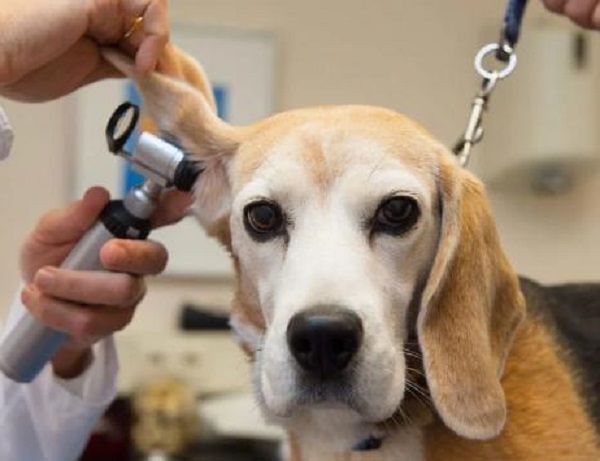Welcome to our latest article, “Recognizing Canine Ear Infections: Telltale Signs of Allergy-Related Issues in Your Dog.” When we typically think of dog allergies, we envision constant itching, but it’s crucial to understand that ear infections can be a significant indicator of underlying allergies. In this post, we’ll explore five key signs that may suggest allergies are contributing to your dog’s ear problems and emphasize the importance of early detection and intervention.

Allergy-related ear infections are what?
Dog ear infections caused by allergies are caused by allergens’ effects on the skin of the ears, which is similar to how allergies generally affect the body’s immune system. The skin acts as a crucial barrier to keep out external infections, but allergies may weaken this protection by causing inflammatory and immunological reactions. When it comes to ears, allergies may create inflammation in the ear canal, which can result in swelling and a disturbance of the natural defenses that the ears have.
Due to the compromised circumstances caused by the allergic inflammation, bacteria or yeast that are normally prevalent on the skin and in the ears may thrive and multiply quickly. An ear infection develops as a consequence of this growth. Recurrent ear problems may result from the cycle of inflammation, itching, and subsequent infections if the underlying allergy is not treated.
Because allergy-related ear infections are persistent, they are difficult to treat unless the particular allergen triggering the first immune response is identified and well controlled. Dog ear infections may be prevented and managed by being aware of and treating these underlying allergens.
What Are the Reasons for Dog Ear Infections?

Dog ear infections may result from a number of sources, the most common ones being the peculiar structure of the dog’s ear canal and outside stimuli. An environment that is favorable For infections is created by the characteristic L-shaped and more vertical structure of a dog’s ear canal, which also raises the risk of fluid retention. The following are typical causes of dog ear infections:
- Growth of Bacteria and Yeast: These two, or a combination of them, are the most common causes of ear infections. These microbes thrive in the ear anatomy of dogs because of their propensity to retain moisture.
- Ear Mites in Puppies: Ear mites may cause ear infections in young dogs, particularly puppies, which expands the list of possible infection causes.
- wetness Accumulation: An abundance of wetness, whether from bathing, swimming, or the surrounding environment, may foster the growth of yeast and bacteria.
- Allergies: Dogs that suffer from allergies are more likely to have ear infections, especially if they also have food sensitivities or allergic skin illness. The ear’s natural defenses might be compromised and inflammation can be exacerbated by allergic responses.
- Endocrine Disorders: The relationship between ear health and general health is highlighted by the fact that diseases such as Thyroid disorders may increase a dog’s susceptibility to ear infections.
- Autoimmune Disorders: Due to weakened immune systems, dogs with autoimmune diseases may be more susceptible to ear infections.
- Wax Buildup: Earwax buildup may hinder regular cleaning and create an atmosphere that is vulnerable to infection.
- Foreign Bodies: In dogs who investigate their environment or play in debris-filled regions, objects stuck in the ear may cause discomfort and illness.
- injury to the Ear Canal: The ear canal is more vulnerable to infections after trauma or other injury.
- Over Cleaning: Cleaning your ears too often might remove natural defenses, throw off your equilibrium, and make you more susceptible to infections.
Symptoms of Dog Ear Infections
Recognizing the signs of dog ear infections is essential for preventative pet care. While some dogs could show less obvious symptoms of pain, including a buildup of wax, others might show more overt evidence of discomfort. Dog ear infections often cause the following symptoms:
- Head Shaking: When there is pain or irritation in the ear, dogs may shake their heads wildly.
- Petting or Scratching at the Affected Ear: A dog will seek to relieve pain or discomfort by pawing or scratching at the affected ear repeatedly.
- Dark Discharge: The existence of a dark, often foul-smelling discharge coming from the ear might be a certain sign of an active infection.
- Odor: An unpleasant odor coming from the ear is often connected to inflammation or an infection.
- Ear Canal Redness and Swelling: Visible ear canal redness and swelling may result from inflammation, which adds to the dog’s general discomfort.
- Discomfort: It may be obvious to see symptoms of discomfort, such as crying or complaining or refusing to have the afflicted ear touched.
- Itching: A frequent reaction to the discomfort brought on By an ear infection is persistent itching, either within or outside the ear.
- Crusting or Scabs in the Ears: If there are crusts or scabs within the ears, there are persistent problems that need to be taken care of.
Treating Dogs’ Allergy-Related Ear Infections

Treating dog ear infections caused by allergies effectively requires a multifaceted strategy that addresses the underlying allergic triggers as well as the symptoms that are present at the moment. This is a summary of the course of treatment:
- Identification of Allergen: An important initial step is to identify the particular allergen that is causing the ear infections. To find and understand the root of the issue, comprehensive testing for food, contact, and inhalant allergies must be performed.
- Ear Cleanse: A veterinarian would usually clean the afflicted ear thoroughly but gently before beginning therapy. A thorough clearance of dirt and infection is ensured by the frequent use of sedation or anesthetic throughout this cleaning operation.
- Medication: The specific requirements of each dog are taken into account when prescribing medication to treat ear infections caused by allergies. The findings of a culture or microscopic screening determine the medicine to be taken. Antibiotics, antifungal medicines, topical therapies (ointments or drops), antihistamines, and anti-inflammatories are among the often given pharmaceuticals. The choice is determined on the kind and intensity of the ear infection.
- Continued Monitoring and Repeated Treatments: These measures may be required in accordance with the infection’s severity. To guarantee complete treatment and healing, ear washes may need to be repeated in the veterinarian’s office within a few days.
- Allergy Management: In order to stop a relapse, it is essential to treat the underlying allergy. It’s crucial to put plans in place to control and reduce exposure to the identified allergy. This might include allergen-specific treatments, dietary adjustments, or environmental adjustments.
What should you do if your dog exhibits any of these symptoms?
It’s critical to act quickly for your dog’s health if they exhibit any of the signs of an ear infection. Dogs that have ear infections may experience discomfort and agony, so it’s critical to get veterinarian treatment as soon as possible. If any of these signs are present in your dog, you should perform the following:
- Seek Veterinary Care Right Away: Make an appointment with a veterinarian as soon as you see any symptoms, including head shaking, ear scratching, black discharge, odor, redness, swelling, soreness, itching, or crusting.
- Early Diagnosis and therapy: Effective therapy and an early diagnosis depend on veterinary care. The veterinarian will do an otoscopic examination in order to thoroughly examine the ear canal and detect any anomalies. Samples may be gathered for further testing if needed.
- Professional Advice: Pay attention to your veterinarian’s advice on the suggested course of therapy. This might include treating any underlying allergies, prescribing antibiotics or antifungal medicines, and, if necessary, cleaning out the ears thoroughly.
- Monitoring and Follow-Up: Make sure to follow the recommended treatment plan and keep an eye out for any changes in your dog’s ears. It may be essential to schedule follow-up visits to make sure the infection is clearing up and to treat any lingering issues.
- Preventive Actions: Take preventive measures to avoid ear infections in the future. This might include cleaning your pet’s ears on a regular basis, treating any possible allergies, and following any preventative advice your veterinarian may have given you.
A Note on Food Allergies
Food allergies in dogs can manifest in various ways, impacting their health and well-being. Among the most common food allergens for dogs are animal proteins, with beef, dairy, and chicken being primary culprits, closely followed by wheat and lamb.
To address potential food allergies, consider opting for dog food that eliminates these top allergens. A high-protein diet that excludes common allergens, including pork, egg, corn, and soy, can be beneficial.
If you suspect your dog’s health issues, such as recurrent ear infections, may be linked to a food allergy, transitioning to a specialized diet might offer relief. Prioritize your dog’s nutrition by choosing options that cater to allergen-conscious formulations.
Conclusion
Early detection of canine ear infections is critical for preventive therapy, especially when allergies are involved. Early symptom detection facilitates immediate veterinarian care, including thorough cleaning and appropriate therapy. Maintaining your dog’s general health and avoiding a recurrence require treating both the current illness and the underlying allergens. For your pet, quick intervention and a thorough approach are key to optimum ear health.
